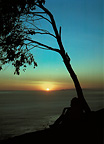











The Friedman Archives Photo Expeditions
China's Nujiang River Gorge
A Journey into the heart of the "Three Parallel Rivers" Region
Enrollment for this trip is now closed. But you can still read about it below.
As many of you know, I spent about six months in China in 2003, and found the country, its people, and the landscape simply unforgettable. I have always wanted to return to see more of the country, and now I have found the right travel industry partner (who also has a background in photography!) to make it happen.
Yunnan is one of China’s most colorful provinces with 25 of China's 55 ethnic groups. The Nu Jiang Canyon is among the most remote and mysterious areas within Yunnan, and much of the region had been unexplored due to its inaccessibility. During your journey, you will not only witness some of the most stunning natural scenery in China, you’ll also come across many different ethnic groups with distinctive cultures and religions which are still very much original and uninfluenced by the outside world.



The Three Parallel Rivers region is in the Northwest corner of the Yunnan province. Our journey begins in Shanghai but very quickly takes you to the rural China which is changing very dramatically as China continues its rampant march to capitalism. This particular region is of extra historical significance, since China is in the process of building a large hydroelectric dam, displacing its people and permanently altering this beautiful region of the world. Nujiang was Inscribed as a UNESCO World Heritage Site in 2003.
We will see an extraordinarily wide variety of scenics: Snow-capped mountains, valleys, Alpine wetlands, virgin forests and meadows, fresh water lakes, steep river gorges, and rare animals / plants. The region contains a whopping 22 ethnic minority groups with distinctive tongues, cultures, and beliefs: Naxi, Tibetan, Pumi, Bai, Yi, Nu, Drung... we will be spending time with some of these tribes as well.
One of the main benefits you can expect to reap from this trip is to practice your ability to interact with your subjects first and break the ice before taking pictures (as opposed to taking candids with a long lens, which just isn't as adventurous and is often considered rude.) You will also have plenty of opportunity to sharpen your ability to pre-visualize your images, and "see" your surroundings in new ways. This is accomplished partly through the various photo-swapping evenings we will have throughout the week, since you can see how others saw the very same environment you were in, and it will stimulate your "how can I make this next shot better?" thinking process in future outings. You will also be traveling with a bunch of friendly photographers who will be challenging themselves to do the same thing. Never will you feel rushed or derided because you want to stop or stay somewhere and take a picture. We are all here to encourage each other to be as creative as we can. The fact that we're surrounded by a beautiful and amazing culture is just icing on the cake!
Dates: March 16-25, 2009
Duration: 10 days
Number of people: 15
Detailed Itinerary: (See below. It's a pretty full schedule!)
Cost: USD $2,300 per person (based
on the current exchange rate and two people to a room). Fees are slightly higher if single occupancy is
required.
The package includes all meals, housing, transportation within China, and
any park entrance fees. Because participants will be arriving
from all over the world, we cannot arrange group rates to get to China. You will
need to make travel arrangements to Shanghai on your own.
It should be emphasized that this is a trip for serious travelers. The accommodations will be 2-star (the best the areas have to offer) and the food will be very local - wild mountain vegetables, mushrooms, potatoes, chicken, pork, eggs, noodles and rice etc. Most chicken dishes are not fillet, but are chopped into pieces with bones attached to the meat when cooked. (Not something most westerners are used to.) The local breakfast can be either congee (rice gruel), preserved vegetables and preserved eggs, steamed buns etc. Milk and yogurt are sold in even the most remote villages stores, so you can bring cereal with you if they think that food might be a problem. If you are used to conventional "tourist" tours or cruise line travel, this is likely not your cup of tea and we kindly invite you to stay home. If, on the other had you have a thirst for new experiences, new and different cultures, have an easy-going attitude, and have a desire to get those "trophy shots" that you just can't get any other way, then this trip is for you!!



DETAILED ITINERARY
Day 1 - Once you get yourself to the Shanghai airport, we will pick you up and whisk you off to our hotel. The program officially starts in the evening, with a welcome dinner, an introductory lecture on the culture, common phrases one ought to know while traveling in this region, and a mini-lecture by Gary about tips / hints / "secrets" of great travel photos. We will wander throughout Shanghai and take photos in the evening, including the Xintiandi Entertainment district; The Bund; and the Nanjing Road Pedestrian Street. Shanghai will be quite a contrast to the rural settings we will see on the rest of the trip.
 Day
2 - More Shanghai shooting in the morning and afternoon: Hongkou
Historic District (Lu Xun Park; Duolun Rd.), the Yu Yuan Garden where we
will see a Confucius Temple built in the Song dynasty; Dongtai Lu Antique
Street; and the "French Concession" (no, not the movie with Gene Hackman --
this is an area of Shanghai once designated for the French). One thing
you will quickly notice about Shanghai in the daytime is the endless
contrasts between old and new -- modern high-rises and centuries-old
villages co-exist side-by-side.
Day
2 - More Shanghai shooting in the morning and afternoon: Hongkou
Historic District (Lu Xun Park; Duolun Rd.), the Yu Yuan Garden where we
will see a Confucius Temple built in the Song dynasty; Dongtai Lu Antique
Street; and the "French Concession" (no, not the movie with Gene Hackman --
this is an area of Shanghai once designated for the French). One thing
you will quickly notice about Shanghai in the daytime is the endless
contrasts between old and new -- modern high-rises and centuries-old
villages co-exist side-by-side.
The day ends with a flight to Kunming, where we check into our hotel at around midnight.
Day 3 - The next morning we continue to fly on to Baoshan, where we will have lunch, and then have a scenic drive to Liu Ku. In the evening we will be treated to an a capella multi-part chorus performed by the local Lisu Tribe.
Day 4 - A full-day photo session in Liu Ku. Grab a distant view of Gaoligong Mountain; and go gallivanting through the Yaojiaping Virgin Forest. We will spend time at a village elementary school and get a chance to play with the kids in addition to photographing them. (Bring a basketball or soccer ball if you're so inclined.) The Yi and Li Su tribes will demonstrate festive celebration rituals for us such as climbing a knife ladder and walking on fire. (These acts are aimed at tourists but are still pretty cool to photograph.)
Day 5 - We travel 248 KM from Liu Ku to Gong Shan to capture the natural phenomenon of the Nujiang River Valley (a closer view of Gaoligong Mountain; Tiger Jump Rock; Moon Rock; Flying Rock); cultural relics (ancient suspension bridges; old Catholic and Christian Churches); and local markets.
Day 6 - Travel to Bing Zhong Luo (44 KM), where we encounter the last of the tattoo-faced Drung women. Then on to Peach Blossom Island, and the first Bend of the Nu River. One of the few Catholic Churches in this area can be found here as well. (Considering how long it took for Catholicism to catch on in China, the folks who established this church were pioneers indeed!!) The day ends with a fascinating tribal family visit in the Bing Zhong Luo village.
 Day
7 -
A little more traveling from Bing Zhong Luo to Fu Gong
(154 KM) to (hopefully) catch the Sun Rise at the Nu River; Cable
River Crossing (photo at right). We also will have the honor of having
dinner with the infamous Li-Su Tribe.
Day
7 -
A little more traveling from Bing Zhong Luo to Fu Gong
(154 KM) to (hopefully) catch the Sun Rise at the Nu River; Cable
River Crossing (photo at right). We also will have the honor of having
dinner with the infamous Li-Su Tribe.
Day 8 - Fu Gong to Liu Ku to Dali (385 KM). It's a long trip, but we we'll be rewarded by breath-taking scenery. We will also get an opportunity to witness the everyday lives of the local ethnic tribes, including bathing rituals. We will spend the night in the Ancient City of Dali.
Day 9 - We continue to explore the city of Dali, including the old town and a cruise on the Er’hai Lake, and a visit to the Xi Zhou Bai ethnic village.
That evening we get on a plane and fly back to Shanghai.
Day 10 - The reverse of Day 1. Breakfast, Goodbye lecture; and several departures to the airport throughout the day. Those with later flights are free to wander and photograph the city, or ignore their surroundings in favor of tweaking their images on their laptop. Peaceful sleep all the way home.


==================
Your Hosts
 |
Gary and Carol Friedman (If you're reading this, you probably already know about Gary's photography, books, his teaching style, and love of travel. If you don't, you can read his bio here.)
|
 |
Jenny Zhou Jenny is one amazing person. Born in Guangzhou, she moved to Vancouver, Canada when she was 10. After graduating college in Canada she spent much of her time traveling and living abroad in Japan and Shanghai (which was used as a home base for visiting much of rural China). After traveling the ancient Silk Road for 4 months Jenny wanted to share her enthusiasm and intimate knowledge of the backcountry with others, and so several years ago she started her own travel agency, which serves more than the purpose of just sight-seeing -- it is geared toward travelers who also want to be enriched by the real experiences through their travels, at the same making a positive contribution to the local communities. "I am thrilled to work with Gary on this trip to the Nu Jiang Canyon, as it is one place I hold the most sacred in all of China", says Jenny. "To be the one to gradually unveil this untouched jewel to you over the course of this 10-day journey is what grants me the highest level of professional satisfaction". Jenny is fluent in Mandarin, Cantonese, Japanese, and English. AND she's an amateur photographer too, which means she understands our eccentric travel needs and the concept of "good light". |

Below is a close-up of the Yunnan Province:

Back to the Friedman Archives Home page